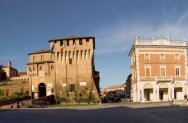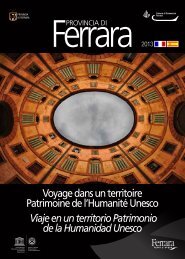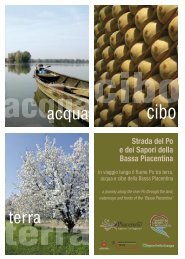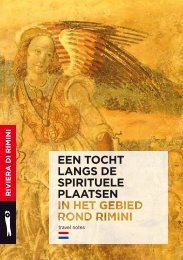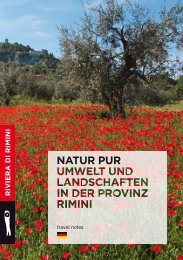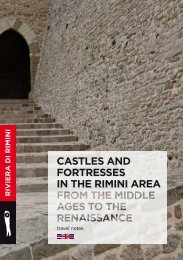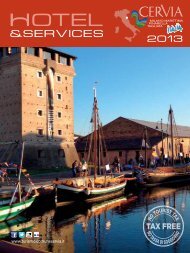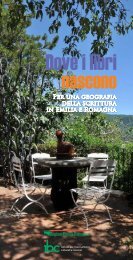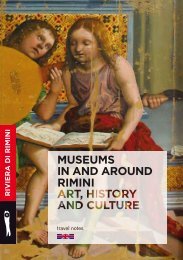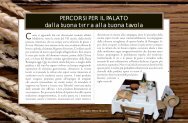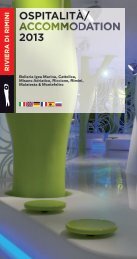Uppennino piacentino - Emilia Romagna Turismo
Uppennino piacentino - Emilia Romagna Turismo
Uppennino piacentino - Emilia Romagna Turismo
You also want an ePaper? Increase the reach of your titles
YUMPU automatically turns print PDFs into web optimized ePapers that Google loves.
Luoghi impervi, dove Liguri e Romani si arroccarono in castellieri e case-torri, dove il ricordo del<br />
passaggio di Annibale si immortala nei borghi della selvaggia Val Boreca, e poi rotola verso il campo<br />
di battaglia, giù a valle, sul fiume Trebbia.<br />
Già, a valle… dove qualcuno (chissà quando) perse l'unico bronzeo fegato mai ritrovato di un<br />
aruspice etrusco, custodito oggi nel museo <strong>piacentino</strong> di Palazzo Farnese.<br />
Tra le pieghe di un suolo che verso sud si corruga sempre più, si nascondono la ricca Veleja romana,<br />
un villaggio neolitico in riva al Trebbia, insediamenti delle Età del Bronzo e del Ferro, un altare<br />
sacrificale, un dolmen.<br />
Le montagne poi custodiscono memorie di Re Longobardi, di terre donate ai Monaci perché<br />
cancellassero secoli di angoscia, e così sorse anche un'abbazia talmente importante da legare a sé il<br />
mistero della sua scomparsa, cancellando il nome di una valle intera.<br />
E Colombano, patrono d'Europa, poté fondare il suo monastero, immenso custode del sapere<br />
umano che vide trascrivere devotamente Cicerone, Plauto, Seneca e Virgilio.<br />
Le varianti della Via Francigena, siglate dai grandi cenobi, furono poi costellate di hospitalia e<br />
oratori, puri e preziosi scrigni romanici della fede.<br />
Anche le grandi Famiglie in lotta hanno frugato il nostro Appennino, scegliendo quello sperone<br />
roccioso o quell'altura dove le maestranze avrebbero eretto alcuni tra i borghi ed i castelli più belli<br />
d'Italia, da noi naturalmente.<br />
secoli e millenni<br />
centuries and millennia<br />
Inaccessible places, where Ligurians and Romans hid themselves in castles and tower houses,<br />
where the wild Boreca Valley still bears signs of the passage of Hannibal, up to the real battlefield,<br />
in the valley crossed by the river Trebbia.<br />
Right, the valley… where someone (who knows when) lost the only bronze liver belonging to an<br />
Etruscan aruspex, which is now preserved in Farnese Palace Museum.<br />
Moving southwards, the ever more rugged soil reveals the rich Veleja Romana, a Neolithic village<br />
on the banks of the river Trebbia, Bronze and Iron age settlements, an altar for sacrifices, a<br />
dolmen.<br />
The mountains preserve memories of Longobardic kings, of lands donated to the monks to forget<br />
centuries of anguish: that's how a very important monastery was born, and then, mysteriously,<br />
vanished, erasing the name of a whole valley.<br />
Columba, patron saint of Europe, was able to found his monastery, which aimed to safeguard<br />
human knowledge; here Cicero, Plautus, Seneca and Virgilius were faithfully transcribed.<br />
The different tracts of Via Francigena, are marked by rest areas for pilgrims, and saw the<br />
construction of hospitalia and oratories, pure and precious Romanesque receptacles of faith.<br />
Even very important families, fighting against each other, searched our Apennines, finally<br />
choosing that rocky spur or that peak where to build some among the most beautiful castles and<br />
boroughs in Italy, here, naturally.<br />
<strong>Uppennino</strong> <strong>piacentino</strong><br />
unico naturalmente / naturally unique<br />
www.uppennino<strong>piacentino</strong>.com



